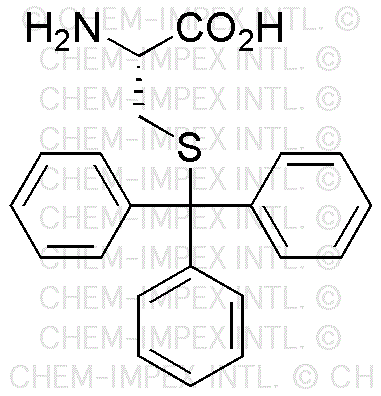S-Trityl-L-cysteine is widely utilized in research focused on:
- Peptide Synthesis: This compound serves as a protecting group for cysteine residues in peptide synthesis, allowing for the selective modification of other amino acids without affecting the cysteine. This is crucial in developing complex peptides used in pharmaceuticals.
- Drug Development: It plays a role in the design of novel drugs, particularly in creating compounds that target specific biological pathways. Its unique structure can enhance the stability and efficacy of therapeutic agents.
- Bioconjugation: S-Trityl-L-cysteine is utilized in bioconjugation processes, where it helps attach biomolecules to surfaces or other molecules, improving the delivery and targeting of drugs in cancer therapy.
- Research in Protein Engineering: This compound is essential in protein engineering, allowing researchers to create proteins with enhanced properties, such as increased stability or altered activity, which can be beneficial in various industrial applications.
- Analytical Chemistry: It is used in analytical methods to study protein interactions and modifications, providing insights into biochemical processes that are vital for understanding diseases and developing new treatments.
General Information
Properties
Safety and Regulations
Applications
S-Trityl-L-cysteine is widely utilized in research focused on:
- Peptide Synthesis: This compound serves as a protecting group for cysteine residues in peptide synthesis, allowing for the selective modification of other amino acids without affecting the cysteine. This is crucial in developing complex peptides used in pharmaceuticals.
- Drug Development: It plays a role in the design of novel drugs, particularly in creating compounds that target specific biological pathways. Its unique structure can enhance the stability and efficacy of therapeutic agents.
- Bioconjugation: S-Trityl-L-cysteine is utilized in bioconjugation processes, where it helps attach biomolecules to surfaces or other molecules, improving the delivery and targeting of drugs in cancer therapy.
- Research in Protein Engineering: This compound is essential in protein engineering, allowing researchers to create proteins with enhanced properties, such as increased stability or altered activity, which can be beneficial in various industrial applications.
- Analytical Chemistry: It is used in analytical methods to study protein interactions and modifications, providing insights into biochemical processes that are vital for understanding diseases and developing new treatments.
Documents
Safety Data Sheets (SDS)
The SDS provides comprehensive safety information on handling, storage, and disposal of the product.
Product Specification (PS)
The PS provides a comprehensive breakdown of the product’s properties, including chemical composition, physical state, purity, and storage requirements. It also details acceptable quality ranges and the product's intended applications.
Certificates of Analysis (COA)
Search for Certificates of Analysis (COA) by entering the products Lot Number. Lot and Batch Numbers can be found on a product’s label following the words ‘Lot’ or ‘Batch’.
*Catalog Number
*Lot Number
Certificates Of Origin (COO)
This COO confirms the country where the product was manufactured, and also details the materials and components used in it and whether it is derived from natural, synthetic, or other specific sources. This certificate may be required for customs, trade, and regulatory compliance.
*Catalog Number
*Lot Number
Safety Data Sheets (SDS)
The SDS provides comprehensive safety information on handling, storage, and disposal of the product.
DownloadProduct Specification (PS)
The PS provides a comprehensive breakdown of the product’s properties, including chemical composition, physical state, purity, and storage requirements. It also details acceptable quality ranges and the product's intended applications.
DownloadCertificates of Analysis (COA)
Search for Certificates of Analysis (COA) by entering the products Lot Number. Lot and Batch Numbers can be found on a product’s label following the words ‘Lot’ or ‘Batch’.
*Catalog Number
*Lot Number
Certificates Of Origin (COO)
This COO confirms the country where the product was manufactured, and also details the materials and components used in it and whether it is derived from natural, synthetic, or other specific sources. This certificate may be required for customs, trade, and regulatory compliance.


